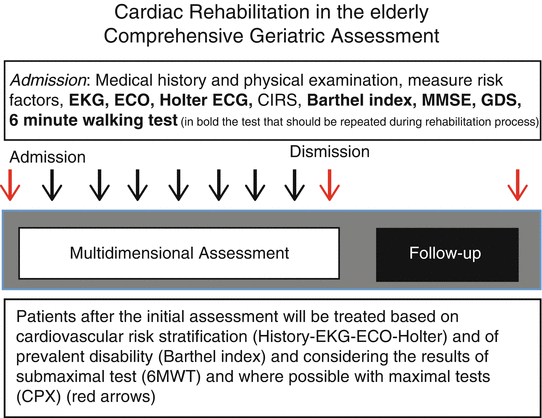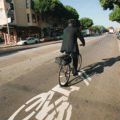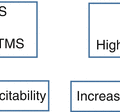Fig. 42.1
Comprehensive geriatric assessment—from the assessment to interventions
The CGA uses tools of different grading: the most commonly used in rehabilitative environment are the Activity of Daily Living (ADL), [24] Barthel Index [25], Cumulative Illness Rating Scale (CIRS) [26], Geriatric Depression Scale (GDS) [27], Mini-Mental State Examination (MMSE) [28], and functional assessment (6-minute walking test) [29], more oriented to the evaluation of cardiac patients, while the Tinetti [30] and the Short Physical Performance Battery (SPPB) [31] are tests used to evaluate balance and gait and physical functioning (Fig. 42.2).


Fig. 42.2
Comprehensive Geriatric Assessment in elderly patient underwent cardiac rehabilitation.
The evaluation of these functions is of great importance especially in the very elderly. In this regard, Lavie et al. showed that the cardiovascular rehabilitative intervention leads to an improvement of the health status in general and the quality of life and a decrease in perceived pain. Furthermore, hostility, depression, and anxiety are reduced to a greater extent in the oldest-old than in adults after cardiovascular rehabilitation [20, 21].
42.4 Specific Protocols for Elderly Patients
To set the subdivision criteria of elderly subjects, in order to identify the best targets to be pursued with rehabilitation, we can refer, in a schematic way, to the cognitive and motor functions that are respectively expressed in the ability to perform, despite the presence of cognitive impairment, a functional recovery path, and preserved autonomy in performing IADL and ADL. At the moment, however, no known studies using the multidimensional assessment oriented to rehabilitation have demonstrated the effectiveness of particular rehabilitation protocols. The questions that need answering are oriented to understanding if this population with conditions such as cognitive impairment, disability, and frailty get a clinical and functional improvement with protocols designed to these special populations.
Physical rehabilitation, implemented in accordance with the risk assessment criteria related to the exercise and adapted to the different disease patterns, is an integral part of management of patient with cardiovascular disease. For rehabilitation purposes we have to make a distinction in the context of this population considering the burden of disability. As already mentioned, the patient with disability tends to coincide with the complex patient, embracing a wide spectrum of cardiovascular conditions and possibly extra-cardiac comorbidity associated with the underlying cardiac disease, characterized by varying degrees of impairment of functional capacity. This impairment arises from a disability, which, through a limitation of usual and, therefore, a restriction of the individual’s participation in his social life, determines different degrees of disability.
The rehabilitative intervention may be configured in patients less compromised in a physical training program, while the more functionally limited patients may be subjected to physical activity that, as controlled and programmed, cannot constitute a classical exercise program of effective workout. In any case, the patient’s physical cardiovascular rehabilitation configures an operational framework “TEAM” involving in various reasons many actors (doctor, nurse, physiotherapist, etc.), with loads and different goals depending on the degree of disability. The rehabilitation process of these patients will be strictly individualized in relation to their functional impairment/disability at admission and the usual functional capacity. The following proposed protocols do not follow the traditional approach of rehabilitation nosology in cardiology (i.e., different protocols for different events or acute or chronic diseases), but rather suggest a transversal criterion for various conditions, based on different levels of disability of patients.
42.5 The Patient with Severe Chronic Disability
The patient with severe chronic disability is defined as a patient with at least 3 ADL lost [32] even present before the acute event. Patients in this category have to be defined as chronic disable. This category includes complex patients chronically bedridden for cardiac causes (refractory heart failure) or noncardiac causes (neurological complications with severely disabling outcomes, severe cognitive impairment, severe orthopedic limitations, etc.). The approach to severe chronic disability patient starts from the assessment and management of clinical stability and prevention of adverse events. In fact, soon after the acute phase of various clinical pictures (i.e., myocardial infarction, unstable angina, pulmonary edema, stroke, etc.), a passive mobilization of the patient is at least advisable for the prevention of thromboembolic event due to bedridden, passing then, if possible, a physical activity program based on the procedures showed in Table 42.1.
Table 42.1
Individualized protocols of training based on disability status
Severe chronic disability | Temporary severe disability | Mild/moderate disability | Without disability |
|---|---|---|---|
Mobilization sessions: active/passive | Mobilization sessions: active/passive | Training sessions of variable load exercise with assistive movement training apparatus | Sessions of variable load exercise using bike and treadmill as effective workout stimulus increasing intensity and sessions |
Diaphragmatic respiratory gymnastics | Diaphragmatic respiratory gymnastics | Diaphragmatic respiratory gymnastics | Diaphragmatic respiratory gymnastics |
Posture changes | Posture changes | Sessions of breathing exercises and calisthenics at a reduced energy expenditure, low, medium, or high | Sessions of breathing exercises and calisthenics at a reduced energy expenditure, low, medium, or high |
Reeducation sessions in motor impairment | Reeducation sessions in motor impairment | Sessions of strengthening of individual muscle groups | Sessions of strengthening of individual muscle groups |
Sessions of bronchial unblocking | Sessions of bronchial unblocking | ||
Sessions of calisthenics exercises | Sessions of calisthenics exercises | ||
Sessions with a muscle stimulation | Sessions with a muscle stimulation | ||
Muscle strengthening sessions | Muscle strengthening sessions | ||
Training sessions gait and walk |
The physiotherapy load in these patients is high.
The objectives and outcomes of the rehabilitation for the patient with severe chronic disability are showed in Tables 42.2 and 42.3.
Table 42.2
Objectives of the rehabilitation based on disability status
Severe chronic disability | Temporary severe disability | Mild/moderate disability | Without disability |
|---|---|---|---|
Improve the patient’s ability to perform ADL | Improve the patient’s ability to perform ADL | Improve the patient’s ability to carry out the usual ADL | Increase the patient’s functional capacity through training of the resistance and/or strength |
Reduce the level of supervision in ADL | Increase, if possible, the patient’s functional capacity | Increase the patient’s functional capacity through training of the resistance and/or strength | Determine a training load applied at home once the patient has been discharged |
Minimize the deconditioning due to loss of muscle tone | Reduce the level of supervision | If possible, determine a training load applied at home once the patient has been discharged | |
Reduce adverse events | Minimize the deconditioning due to loss of muscle tone | ||
Resolution of the bedridden and for the continued rehabilitation intervention as physical training |
Table 42.3
Outcome of the rehabilitation based on disability status
Severe chronic disability | Temporary severe disability | Mild/moderate disability | Without disability |
|---|---|---|---|
Increase in the score of disability scales administered at the beginning of the rehabilitation process | Increase in the score of disability scales administered at the beginning of the rehabilitation process | Increase in the score of disability scales administered at the beginning of the rehabilitation process | The increase of 6-minute walking test distance |
If possible, the formal documentation of the termination of the setting bed using 6-minute walking test
Stay updated, free articles. Join our Telegram channel
Full access? Get Clinical Tree
 Get Clinical Tree app for offline access
Get Clinical Tree app for offline access

|


